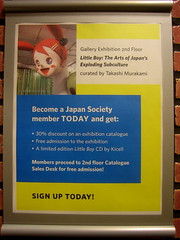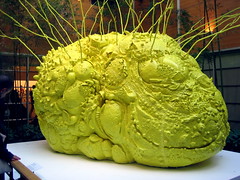Little Boy: The Arts of Japan's Exploding Subculture
Went to the Japan Society

last Sunday to check out the Little Boy exhibit curated by Takashi Murakami. The exhibition focuses on work that is representative of Otaku culture. Common themes included large eyes, robots, hybird creatures, animations, and the struggle between adolescence and the emergence of sexuality.
The Japan Society exhibit space is not that large, however the interior of the space flows well from one area to another which prevents a feeling of being crowded. There was a lot of work in the Little Boy Exhibit but all the pieces were given their own ample space, which is usually not the case when an exhibit is featured in a small space with a lot of work.
The first striking piece that is visible even before the exhibition is Fresh Gasoline by Noburu Tsubaki. It is a large yellow organ looking blob with long, stiff tendrils that extend toward the ceiling of the space.

Styrofoam, Clay, Willow Branches and Paint
Upon entering the beginning of the exhibit, a large green robot called a Zaku head
 sits in the middle of the room making an intermittent sound as a pink eye rotates in its head. To the right of the Zaku head is a flat panel tv playing a loop of the Yuru Chara Show
sits in the middle of the room making an intermittent sound as a pink eye rotates in its head. To the right of the Zaku head is a flat panel tv playing a loop of the Yuru Chara Show  which features a variety of mascots parading onstage to different electronic music genres like techno version, downbeat version and trance version (even though the labeled genres did not match the music that was actually playing).
which features a variety of mascots parading onstage to different electronic music genres like techno version, downbeat version and trance version (even though the labeled genres did not match the music that was actually playing).There was an entire wall dedicated to Hello Kitty that showed various Hello Kitty
 parphernalia; from Hello Kitty pillows to lunchboxes to figurines. It brought back my Hello Kitty obsession when I was younger. I used to collect Hello Kitty stationary that I would never write on, but I did write my childhood secrets in my Hello Kitty diary that had the easiest lock you could pick with a bent paperclip. An LCD TV was playing an intense motion graphics sequence of Hello Kitty's transformations from 1974 to 2005.
parphernalia; from Hello Kitty pillows to lunchboxes to figurines. It brought back my Hello Kitty obsession when I was younger. I used to collect Hello Kitty stationary that I would never write on, but I did write my childhood secrets in my Hello Kitty diary that had the easiest lock you could pick with a bent paperclip. An LCD TV was playing an intense motion graphics sequence of Hello Kitty's transformations from 1974 to 2005. Aya Takano had an entire wall of her seemingly innocent girly figure acrylic on canvas pieces. When looking closer, some of the acrylic paintings are actually renderings of scenes like a torso fucking a stuffed animal with a black bunny watching, a used bloody tampon on the floor and a girl masturbating with crayons.
Shigeru Komatsuzaki was the first artist to create e-monogatari, which are serialized picture stories.


The images above were not in the Little Boy Exhibit, they are just examples of his work, which are incredibly detailed and have a bionic/superfuture aesthetic to them.
Doraemon, the "22nd century cat from the future"
 also had a presence in the form of an LCD TV and a sculpture.
also had a presence in the form of an LCD TV and a sculpture. An entire wall of black godzillas lined up the entrance to the second part of the exhibition. Behind the row of black godzillas was Article 9, the Declaration of War on Japan by the US. It was a very striking installation that raised issues of the atom bomb and how different Japan and its culture would be if the war never happened and the bomb were never dropped.

The second part of the exhibition featured a room that contained a glass box that took up an entire wall that was filled with vintage toys from brands like Kikkoman. In the room with the glass box full of vintage toys were these wooden baby sculptures with neon accents by Izumi Kato.
An entire wall was covered with the cells from the beginning of the Daicon IV animation.
Tohl Narita, the creator of Ultraman draws these crazy hybrid creatures like armadillo fish platypus creatures. I would think that
Kool Keith created his lyrics based on creatures that look like this.

Atom Suit Project was the name of the piece that entailed a life size robot surrounded by miniature robots that beeped in the middle of the third part of the exhibition was made by Kenji Yanobe.

Sushi with etchings of naked women sitting on top of a woman shaped canvas was a very meta-commentary piece on women used as sushi platters.
The Little Boy Exhibit is a very accessible, colorful and fascinating exhibit that is installed extremely well. People that are Japanophiles are obvious fans for this show, but even if you aren't very informed about Japanese pop culture it is a very intriguing insight into Otaku culture
0 Comments:
Post a Comment
<< Home